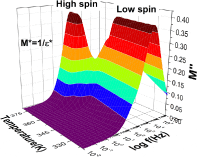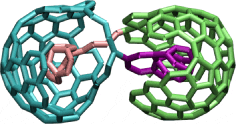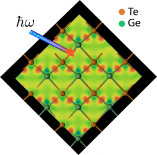Welcome to the latest selection of recent top articles in the physica status solidi journals. Get a glimpse of our publication spectrum and visit our pages by clicking on any of the DOI links below.
Dielectric and charge transport properties of the spin crossover complex [Fe(Htrz)2(trz)](BF4) [Rapid Research Letter]
Constantin Lefter, Il’ya A. Gural’skiy, Haonan Peng, Gábor Molnár, Lionel Salmon, Aurelian Rotaru, Azzedine Bousseksou, and Philippe Demont
 In this Letter, the authors report an AC conductivity analysis on the [Fe(Htrz)2(trz)](BF4) spin crossover complex and reveal the spin-state dependence of the electrical conductivity, permittivity and modulus in a broad frequency range. This study confirms recent findings in spin-state dependent conductivity measurements and highlights a unique behavior of the relaxation frequencies of charge carriers.
In this Letter, the authors report an AC conductivity analysis on the [Fe(Htrz)2(trz)](BF4) spin crossover complex and reveal the spin-state dependence of the electrical conductivity, permittivity and modulus in a broad frequency range. This study confirms recent findings in spin-state dependent conductivity measurements and highlights a unique behavior of the relaxation frequencies of charge carriers.
Phys. Status Solidi RRL (2013) DOI 10.1002/pssr.201308256
Promoting the assembly of carbon onions: an atomistic approach [Original Paper]
Bibek Adhikari, Balaji Muthuraman, Christos Mathioudakis, and Maria Fyta
 Atomistic simulations at two levels, classical and quantum-mechanical, are performed to probe the binding possibilities of the smallest multi-shelled concentric fullerenes, known as ‘carbon onions’. Their binding is promoted through the addition of vacancies and doping. Optimizing the conditions for assembling these nanoscale building blocks will be important for creating novel functional nanomaterials.
Atomistic simulations at two levels, classical and quantum-mechanical, are performed to probe the binding possibilities of the smallest multi-shelled concentric fullerenes, known as ‘carbon onions’. Their binding is promoted through the addition of vacancies and doping. Optimizing the conditions for assembling these nanoscale building blocks will be important for creating novel functional nanomaterials.
Phys. Status Solidi A (2013) DOI 10.1002/pssa.201330082
Spin pumping through quantum dots [Feature Article]
Stephan Rojek, Michele Governale, and Jürgen König
 A substantial aspect of semiconductor spintronics is the generation of spin currents. This goal may be achieved by schemes that rely on pumping of electrons through interacting quantum dots. Their appeal lies in the tunability of the pumping characteristics via gate voltages. We put special focus on the possibility of pure spin pumping in the absence of charge pumping.
A substantial aspect of semiconductor spintronics is the generation of spin currents. This goal may be achieved by schemes that rely on pumping of electrons through interacting quantum dots. Their appeal lies in the tunability of the pumping characteristics via gate voltages. We put special focus on the possibility of pure spin pumping in the absence of charge pumping.
Phys. Status Solidi B (2013) DOI 10.1002/pssb.201350213
Athermal amorphisation of crystallized chalcogenide glasses and phase-change alloys [Feature Article]
Alexander V. Kolobov, Paul Fons, and Junji Tominaga
 Chalcogenide glasses and phase-change alloys are characterised by pronounced bonding energy hierarchy between co-aligned shorter and longer (resonant) bonds. The existing experimental and simulational evidence suggests that it is this hierarchy that makes athermal amorphisation of these materials possible.
Chalcogenide glasses and phase-change alloys are characterised by pronounced bonding energy hierarchy between co-aligned shorter and longer (resonant) bonds. The existing experimental and simulational evidence suggests that it is this hierarchy that makes athermal amorphisation of these materials possible.
Phys. Status Solidi B (2013) DOI 10.1002/pssb.201350146

















